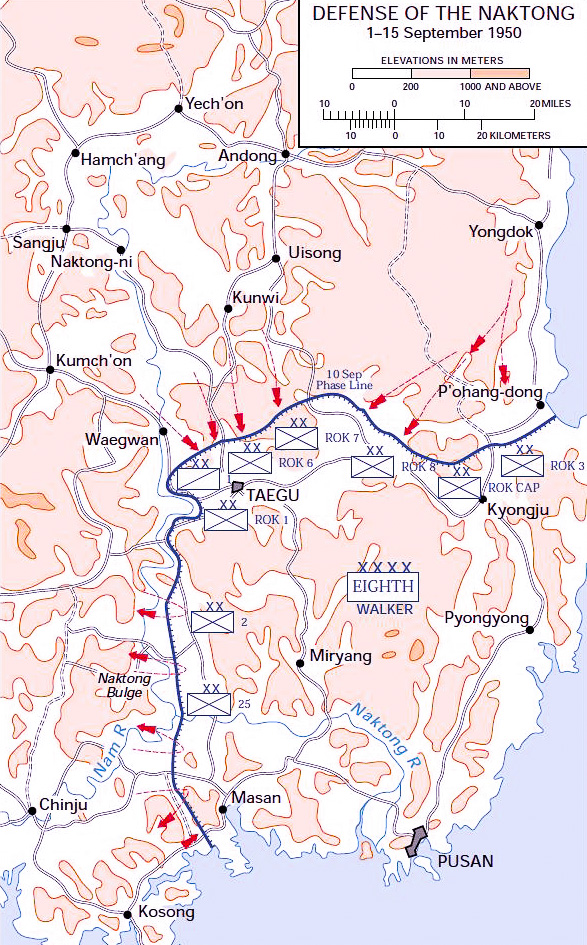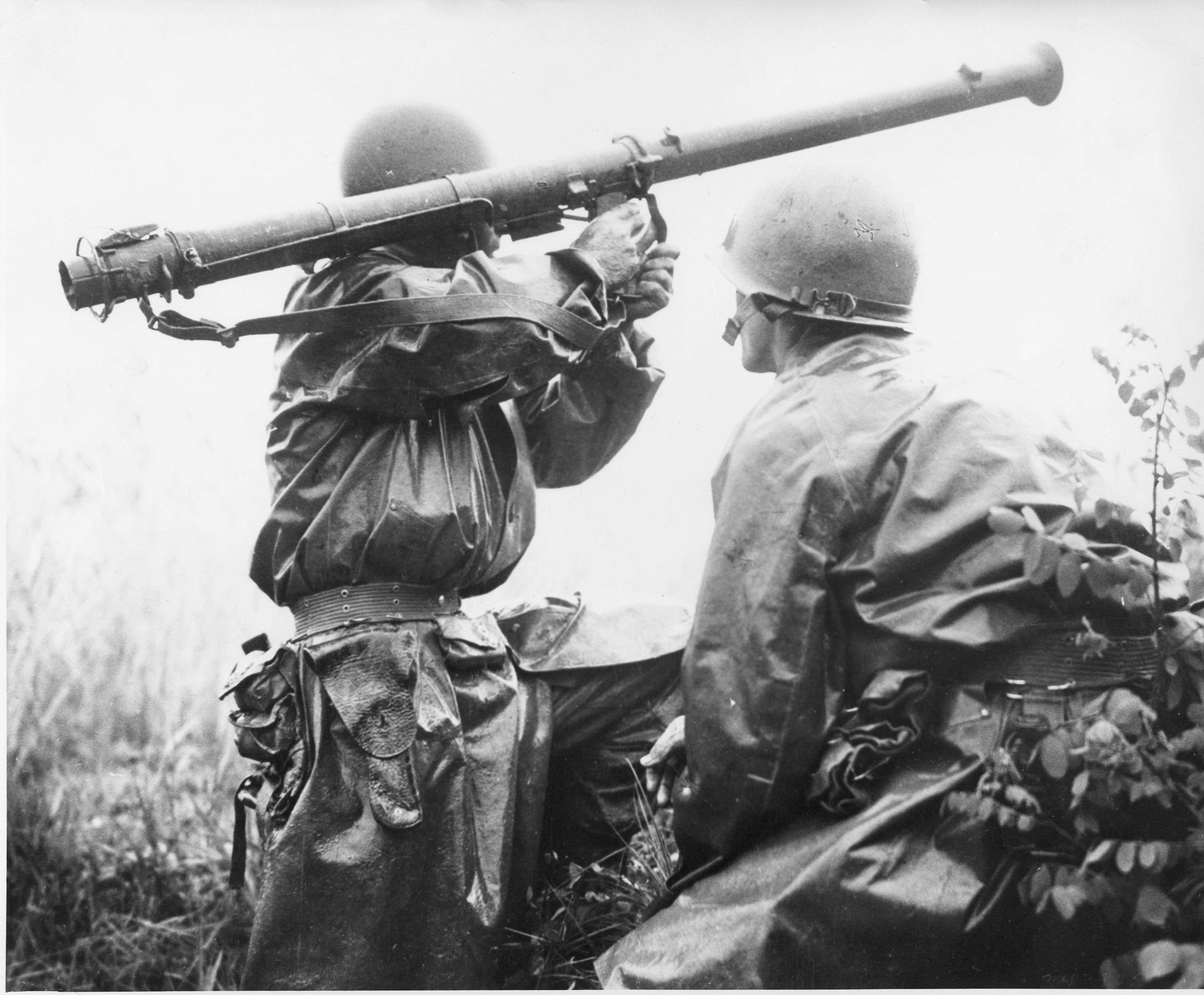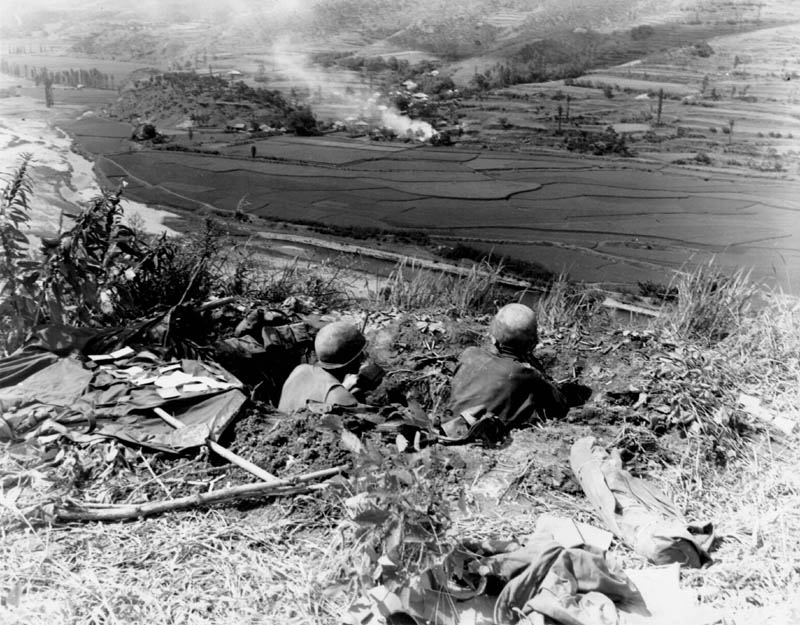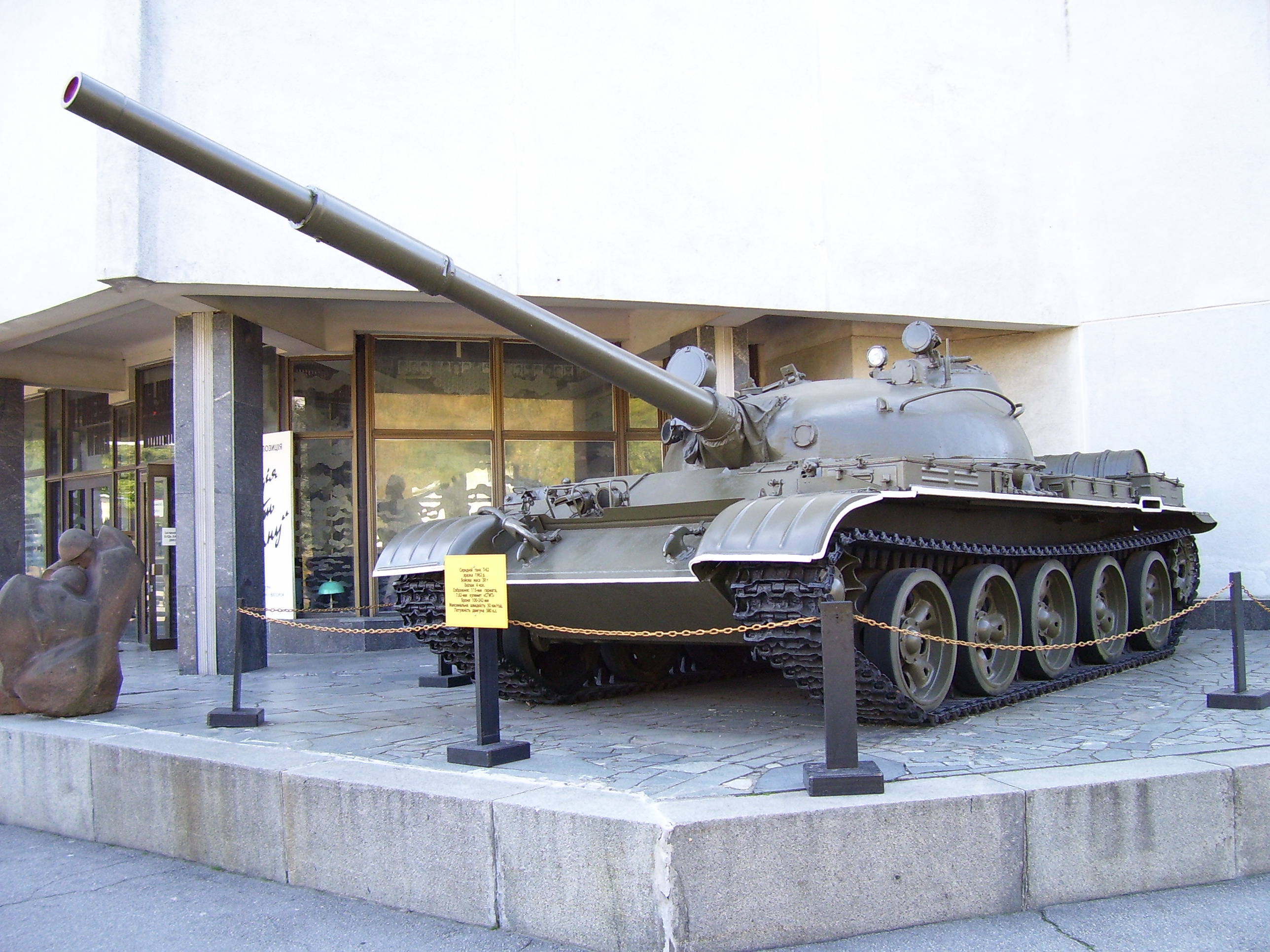|
105th Armored Division (North Korea)
The 105th Guards Seoul Ryu Kyong-Su Armored Division is a military formation of the Korean People's Army. It was North Korea's first armored unit and took part with T-34-85 tanks in the Korean War. Formation and structure The division was established in October 1948 as the "105th Armored Battalion" and given its unit colors by Kim Il-sung a month later. It increased to regimental strength in May 1949. By June 1950, the "105th Armored Regiment" had become the "105th Armored Brigade" with a strength of 6,000 men and 120 T-34 tanks. Its equipment – tanks, weapons and vehicles – was Soviet-made. The brigade had three tank regiments – the 107th, 109th, and 203rd – and a mechanized infantry regiment, the 206th. The "83d Motorized Regiment" was also part of the division during the Korean War. Each tank regiment had three medium tank battalions, each having 13 tanks. Each tank battalion had three tank companies with four tanks to a company. Tank crews consisted of five men. Bat ... [...More Info...] [...Related Items...] OR: [Wikipedia] [Google] [Baidu] |
Armored Division
A division is a large military unit or formation, usually consisting of between 6,000 and 25,000 soldiers. In most armies, a division is composed of several regiments or brigades; in turn, several divisions typically make up a corps. Historically, the division has been the default combined arms unit capable of independent operations. Smaller combined arms units, such as the American regimental combat team (RCT) during World War II, were used when conditions favored them. In recent times, modern Western militaries have begun adopting the smaller brigade combat team (similar to the RCT) as the default combined arms unit, with the division they belong to being less important. While the focus of this article is on army divisions, in naval usage " division" has a completely different meaning, referring to either an administrative/functional sub-unit of a department (e.g., fire control division of the weapons department) aboard naval and coast guard ships, shore commands, and ... [...More Info...] [...Related Items...] OR: [Wikipedia] [Google] [Baidu] |
Pokpung-ho
The P'okp'ung-ho, officially the Chonma-215 and Chonma-216 are North Korean main battle tanks (MBT) developed in the 1990s. The tank may incorporate technology found in the T-62, T-72, and Ch'onma-ho MBTs.Yoon Min Hyeok.북한군 폭풍호전차와 신형 차기전차 분석(KINX2011032815).2010 Outside parties codename the tank M-2002 because the tank went through performance trials on February 16, 2002 (therefore being officially confirmed by outside sources), although the tank may have been in existence since 1992. The P'okp'ung-ho is only known to be used in North Korea. Origin After the dissolution of the Soviet Union, a significant number of T-72s were decommissioned from Soviet service and scrapped for metal. North Korea is believed to have acquired some of these scrapped T-72s and obtained core technology for use on the P'okp'ung-ho through reverse engineering. It is also believed North Korea acquired 3 samples of T-80 in early 1990s from Afghanistan. North Korea's int ... [...More Info...] [...Related Items...] OR: [Wikipedia] [Google] [Baidu] |
Military Units And Formations Of North Korea In The Korean War
A military, also known collectively as armed forces, is a heavily armed, highly organized force primarily intended for warfare. It is typically authorized and maintained by a sovereign state, with its members identifiable by their distinct military uniform. It may consist of one or more military branches such as an army, navy, air force, space force, marines, or coast guard. The main task of the military is usually defined as defence of the state and its interests against external armed threats. In broad usage, the terms ''armed forces'' and ''military'' are often treated as synonymous, although in technical usage a distinction is sometimes made in which a country's armed forces may include both its military and other paramilitary forces. There are various forms of irregular military forces, not belonging to a recognized state; though they share many attributes with regular military forces, they are less often referred to as simply ''military''. A nation's military ... [...More Info...] [...Related Items...] OR: [Wikipedia] [Google] [Baidu] |
Pakchon
Pakch'ŏn County is a ''kun'', or county, in southern North P'yŏngan province, North Korea. It is bordered to the north by T'aech'ŏn, to the east and southeast by Nyŏngbyŏn, and to the west by Unjŏn counties. To the south, it looks across the Ch'ŏngch'ŏn River at Anju city and Mundŏk county in South P'yŏngan province. In 1952, 4 ''myŏn'' of Pakch'ŏn were split off to join Unjŏn county; since then, the county's administrative divisions have been revised in 1954, 1956, 1958, 1978, 1980, and 1982. Geography Pakch'ŏn's terrain is dominated by rolling hills and plains, with few points exceeding 300 m above sea level. The highest point is Ch'ŏngryongsan (청룡산, 322 m). The Pakch'ŏn Plain spreads over 100 km² along the Taeryong and Ch'ŏngch'ŏn Rivers. Only 30% of the county's terrain is forested, with pine the dominant tree, while 50% is cultivated. Administrative divisions Pakch'ŏn county is divided into 1 '' ŭp'' (town), 1 '' rodongjagu'' (workers' ... [...More Info...] [...Related Items...] OR: [Wikipedia] [Google] [Baidu] |
Fifth Air Force
The Fifth Air Force (5 AF) is a numbered air force of the United States Air Force Pacific Air Forces (PACAF). It is headquartered at Yokota Air Base, Japan. It is the U.S. Air Force's oldest continuously serving Numbered Air Force. The organization has provided 80 years of continuous air power to the Pacific since its establishment in September 1941. Fifth Air Force is the Headquarters Pacific Air Forces forward element in Japan, and maximizes partnership capabilities and promotes bilateral defense cooperation. In addition, 5 AF is the air component to United States Forces Japan. Its mission is three-fold. First, it plans, conducts, controls, and coordinates air operations assigned by the PACAF Commander. Fifth Air Force maintains a level of readiness necessary for successful completion of directed military operations. And last, but certainly not least, Fifth Air Force assists in the mutual defense of Japan and enhances regional stability by planning, exercising, and executing j ... [...More Info...] [...Related Items...] OR: [Wikipedia] [Google] [Baidu] |
People's Volunteer Army
The People's Volunteer Army (PVA) was the armed expeditionary forces deployed by the People's Republic of China during the Korean War. Although all units in the PVA were actually transferred from the People's Liberation Army under the orders of Chairman Mao Zedong, the PVA was separately constituted in order to prevent an official war with the United States. The PVA entered Korea on 19 October 1950, and completely withdrew by October 1958. The nominal commander and political commissar of the PVA was Peng Dehuai before the ceasefire agreement in 1953, although both Chen Geng and Deng Hua served as the acting commander and commissar after April 1952 due to Peng's illness. The initial (25 October – 5 November 1950) units in the PVA included 38th, 39th, 40th, 42nd, 50th, 66th Corps; totalling 250,000 men. About 3 million Chinese civilian and military personnel had served in Korea throughout the war. Background Although the United Nations Command (UN) forces were under U ... [...More Info...] [...Related Items...] OR: [Wikipedia] [Google] [Baidu] |
Great Naktong Offensive
The Great Naktong Offensive was a North Korean military offensive against United Nations Command (UN) forces early in the Korean War, taking place from September 1–15, 1950. It was the North Korean Korean People's Army (KPA)'s unsuccessful final bid to break the Pusan Perimeter established by the UN forces. For the first several months of the war, the KPA successfully defeated and pushed back the UN forces south at each encounter. However, by August the UN troops (which were composed mostly of troops from the United States (US) and Republic of Korea Army (ROK) had been forced into the Pusan Perimeter on the southeast tip of the Korean peninsula. For the first time, the UN troops formed a continuous line which the KPA could neither flank nor overwhelm with superior numbers. KPA offensives on the perimeter were stalled and by the end of August all momentum was lost. Seeing the danger in a prolonged conflict along the perimeter, the KPA sought a massive offensive for September ... [...More Info...] [...Related Items...] OR: [Wikipedia] [Google] [Baidu] |
Battle Of Osan
The Battle of Osan ( ko, 오산 전투) was the first engagement between the United States and North Korea during the Korean War. On July 5, 1950, Task Force Smith, an American task force of 540 infantry supported by an artillery battery, was moved to Osan, south of Seoul, the capital of South Korea, and was ordered to fight as a rearguard to delay the advancing North Korean forces while more US troops arrived to form a stronger defensive line to the south. The task force lacked both anti-tank guns and effective infantry anti-tank weapons and had been equipped with obsolete 2.36-inch (60 mm) rocket launchers and a few 57 mm recoilless rifles. Aside from a limited number of HEAT shells for the unit's 105 mm howitzers, crew-served weapons that could defeat T-34/85 tanks from the Soviet Union had not yet been distributed to the US Army forces in Korea. A North Korean tank column equipped with ex-Soviet T-34/85 tanks overran the task force in the first encounter and c ... [...More Info...] [...Related Items...] OR: [Wikipedia] [Google] [Baidu] |
Battle Of Pusan Perimeter
The Battle of the Pusan Perimeter ( ko, 부산 교두보 전투) was a large-scale battle between United Nations Command (UN) and North Korean forces lasting from August 4 to September 18, 1950. It was one of the first major engagements of the Korean War. An army of 140,000 UN troops, having been pushed to the brink of defeat, were rallied to make a final stand against the invading Korean People's Army (KPA), 98,000 men strong. UN forces, having been repeatedly defeated by the advancing KPA, were forced back to the "Pusan Perimeter", a defensive line around an area on the southeastern tip of South Korea that included the port of Busan. The UN troops, consisting mostly of forces from the Republic of Korea Army (ROKA), United States, and United Kingdom, mounted a last stand around the perimeter, fighting off repeated KPA attacks for six weeks as they were engaged around the cities of Taegu, Masan, and Pohang and the Naktong River. The massive KPA assaults were unsuccessful in f ... [...More Info...] [...Related Items...] OR: [Wikipedia] [Google] [Baidu] |
Taejon
Daejeon () is South Korea's fifth-largest metropolis, with a population of 1.5 million as of 2019. Located in the central-west region of South Korea alongside forested hills and the Geum River, the city is known both for its technology and research institutions, and for celebrating its natural environment, with most mountains, hot springs, and rivers freely open for public use. Daejeon serves as a hub of transportation for major rail and road routes, and is approximately 50 minutes from the capital, Seoul, by KTX or SRT high speed rail. Daejeon (along with Seoul, Gwacheon and Sejong City) are collectively South Korea's administration hubs. The city is home to 23 universities and colleges, including Korea Advanced Institute of Science and Technology (KAIST) and Chungnam National University, as well as government research institutes, and research and development centers for global companies such as Samsung, LG, mostly located in the city's Daedeok Science Town. Occupied b ... [...More Info...] [...Related Items...] OR: [Wikipedia] [Google] [Baidu] |
Chonma-ho
The Ch'ŏnma-ho or spelled as Chonma-ho (Chosŏn'gŭl: 천마호; Hanja: 天馬號 meaning 'Pegasus') is one of North Korea's secretive indigenous main battle tank designs. The tank is also known by the name of 천리마 전차 (千里馬 or the " Chollima Tank"). The original Ch'ŏnma-ho is based on the Soviet T-62. There are at least five different operational versions of the Ch'ŏnma-ho. Since its inception, the Ch'ŏnma-ho has apparently undergone several extensive upgrades. Little public information is available about this tank, and its most recent public appearance was the 70th Anniversary Parade held in Pyongyang, North Korea, on 10 October 2015, celebrating the 70th anniversary of North Korea's ruling party. Background After the Armistice Agreement of the Korean War in 1953, North Korea found itself in need of much more modern equipment. Prior to the start of open hostilities, North Korea had acquired 379 T-34s from the Soviet Union. According to a report to th ... [...More Info...] [...Related Items...] OR: [Wikipedia] [Google] [Baidu] |
Korean War
, date = {{Ubl, 25 June 1950 – 27 July 1953 (''de facto'')({{Age in years, months, weeks and days, month1=6, day1=25, year1=1950, month2=7, day2=27, year2=1953), 25 June 1950 – present (''de jure'')({{Age in years, months, weeks and days, month1=6, day1=25, year1=1950) , place = Korean Peninsula, Yellow Sea, Sea of Japan, Korea Strait, China–North Korea border , territory = Korean Demilitarized Zone established * North Korea gains the city of Kaesong, but loses a net total of {{Convert, 1506, sqmi, km2, abbr=on, order=flip, including the city of Sokcho, to South Korea. , result = Inconclusive , combatant1 = {{Flag, First Republic of Korea, name=South Korea, 1949, size=23px , combatant1a = {{Plainlist , * {{Flagicon, United Nations, size=23px United Nations Command, United Nations{{Refn , name = nbUNforces , group = lower-alpha , On 9 July 1951 troop constituents were: US: 70.4%, ROK: 23.3% other UNC: 6.3%{{Cite ... [...More Info...] [...Related Items...] OR: [Wikipedia] [Google] [Baidu] |





